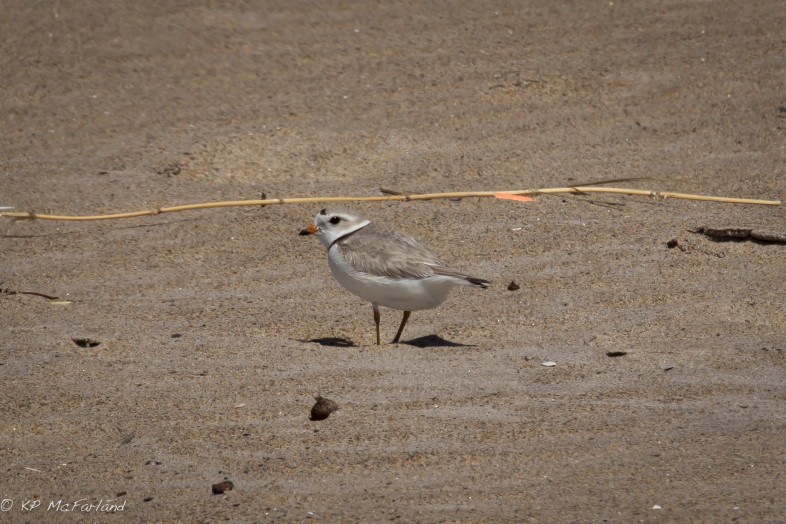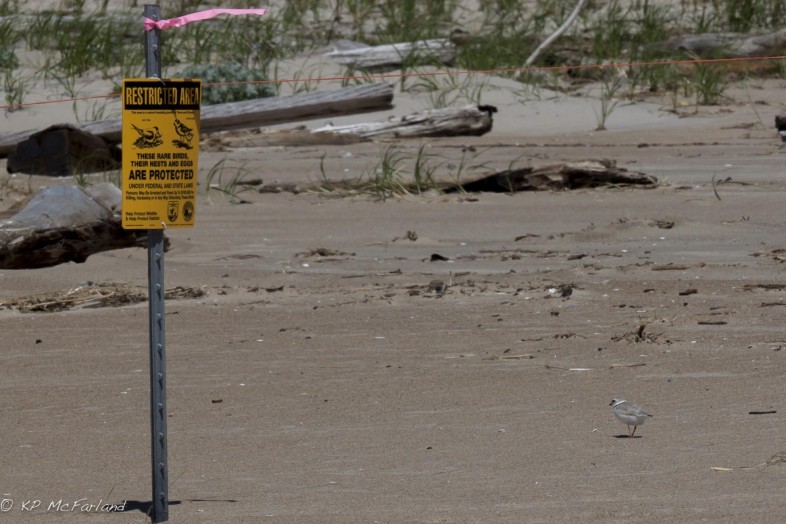CONCORD, N.H. — Be aware of endangered birds on the beaches this holiday weekend and beyond, as the New Hampshire Fish and Game Department reports there are six pairs of piping plovers nesting along the sandy shores of Hampton and Seabrook. Piping plovers are endangered in New Hampshire and threatened nationally. Their breeding habitat is fenced with yellow roping to indicate the birds’ presence to beach-goers and to allow the mating pairs space to nest and raise their young.
“Our goal is to protect these rare birds during their breeding season and manage the beaches for both people and wildlife,” said Brendan Clifford a biologist with the Fish and Game’s Nongame and Endangered Wildlife Program who oversees the piping plover protection effort. “It’s a bit of a later spring this year, so nesting seems a week or two behind.”
“The sooner the birds nest, the sooner the chicks will hatch and grow big enough to be able to fly. Once the chicks are about 30 days old, they can fly and escape from danger and we can take down the fences that protect their breeding habitat and open up the whole beach for recreational use,” explained Clifford.
Within just a few hours of hatching, piping plover chicks are able to walk and feed on their own. The first few weeks after hatching are the most crucial, because the chicks are very small and hard to see and extremely vulnerable to natural predators such as gulls, crows, foxes and domestic animals, including cats and dogs.
Another threat is humans. “We have had occasional incidences where people have deliberately vandalized fencing meant to protect the birds and even stolen eggs right out of the nest,” Clifford said. “We are continuing to educate people in hopes of minimizing instances of human disturbance.”
While Fish and Game cannot monitor the birds 24 hours a day, they do rely on a number of volunteers to keep watch over the birds and activities taking place on the beaches.
N.H. Fish and Game is working closely again this year with beach managers to coordinate beach raking and plover protection. Beach maintenance may occur, as long as it is coordinated in advance with N.H. Fish and Game and does not pose a threat to the piping plovers.
Since protection efforts began in 1997 through 2014, 89 nesting pairs of plovers have fledged 115 chicks on New Hampshire’s seacoast. New Hampshire’s efforts are part of a region-wide protection program; overall, the Atlantic coast population of piping plovers continues to hold steady.
Protection of this endangered species is a cooperative effort of the U.S. Fish and Wildlife Service, N.H. Fish and Game Department, N.H. Division of Parks and Recreation, the Town of Seabrook, the Town of Hampton, volunteers, local residents and beach visitors.

Adult Piping Plover near its nest site. / © K.P. McFarladn
Beachgoers can make a big difference in whether or not piping plover chicks survive to fledgling age:
* Watch where you step – A plover chick’s defense mechanism is to freeze when people get close, which makes it difficult to see. The chicks are about the size of a cottonball and light colored, so they blend in with the sand.
* Leash your dog – Free-running dogs can accidentally step on and crush eggs and chase after the chicks and adult plovers. Hampton Beach State Park and the Town of Seabrook both have restrictions regarding dogs on beaches during the summer. People should check before bringing their dog on any public beach.
* Fill in holes – Holes in the sand are traps for the tiny chicks that can’t fly. Filling in any holes on the beach helps the chicks move about and find the food they need to grow strong and be able to fly.
* Volunteer! – Volunteers will be needed to help with monitoring once the plover chicks begin to hatch around Memorial Day. Anyone interested in volunteering can contact the N.H. Fish and Game Department Piping Plover Monitor at 603-419-9728.
For more information on piping plovers in New Hampshire, visithttp://www.wildlife.state.nh.
The piping plover protection effort is coordinated by Fish and Game’s Nongame and Endangered Wildlife Program, which works to protect 37 threatened and endangered species, as well as hundreds of other species statewide.

